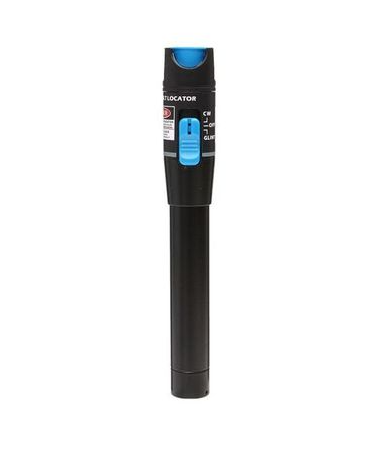
The Essential Guide to Visual Fault Locators for Fiber Optic Cables
What is a Visual Fault Locator (VFL)?
A Visual Fault Locator is a handheld device used to detect faults in fiber optic cables. It works by injecting a visible red laser light (usually in the 650nm wavelength) into the fiber. When the light encounters a fault, such as a break, bend, or bad splice, it leaks out of the fiber, making the fault visible to the naked eye. This makes VFLs an excellent tool for quick, on-the-spot diagnostics.
How Does a Visual Fault Locator Work?
Using a VFL is straightforward. Here’s a step-by-step overview of how it works:
Connect the VFL to the Fiber: The VFL is equipped with a connector that matches the type of fiber optic cable being tested (e.g., SC, LC). The user connects the VFL to one end of the fiber cable.
Activate the Laser: Once connected, the VFL is turned on, and the laser light is injected into the fiber.
Inspect for Leaks: As the laser travels through the fiber, it will exit the cable at any point where there’s a fault. The red light is easily visible, even through the jacket of the fiber, making it easy to locate the precise point of the issue.
Identify the Fault: By following the visible red light, the user can identify where the fault lies, whether it’s a break, bend, or a poorly made splice. This allows for immediate corrective action, such as repairing the fiber or replacing a damaged section.
Why Use a Visual Fault Locator?
VFLs offer several advantages, making them a valuable tool in any fiber optic technician’s toolkit:
Quick and Easy to Use:
- VFLs are user-friendly and provide immediate feedback. Unlike other testing methods that may require interpretation of complex data, the VFL’s visible light gives an instant and clear indication of where the problem is located.
Cost-Effective:
- VFLs are relatively inexpensive compared to other fiber testing equipment like Optical Time-Domain Reflectometers (OTDRs). This makes them an affordable option for both professionals and smaller businesses that need to maintain their fiber optic networks.
Portability:
- Most VFLs are compact and lightweight, designed to be easily carried around in the field. This portability makes them ideal for on-site troubleshooting in various environments, from office buildings to remote outdoor installations.
Versatility:
- VFLs can be used on both single-mode and multi-mode fibers, making them a versatile tool for different types of networks. They are effective at locating faults over short distances, typically up to 5 km, depending on the specific device.
Enhancing Safety:
- By making faults visible, VFLs reduce the risk of accidental fiber damage during installation or maintenance. Technicians can identify and address issues before they lead to more significant problems.
Applications of Visual Fault Locators
VFLs are used in a variety of scenarios within the fiber optic industry:
Installation and Testing: During the installation of fiber optic networks, VFLs are used to ensure that fibers are correctly connected and free of defects before the network goes live.
Maintenance and Troubleshooting: For existing networks, VFLs are essential for routine maintenance checks and quickly identifying the source of a problem when network issues arise.
Splicing Verification: When splicing fibers, VFLs help verify that the splice is done correctly, ensuring there are no breaks or excessive bending at the splice point.
Educational and Training Tools: VFLs are also used in educational settings, helping students and new technicians learn about fiber optic cables and how to identify common issues.
Limitations of Visual Fault Locators
While VFLs are incredibly useful, they do have limitations:
Distance Limitations: VFLs are most effective for short-range testing, typically up to 5 km. For longer distances, an OTDR might be necessary.
Limited to Visible Faults: VFLs can only detect faults that cause light to leak out of the fiber. Issues like small losses in signal strength or internal microbends that don’t cause visible leaks may not be detected.
Not Suitable for Detailed Analysis: While VFLs are great for quick checks, they do not provide the detailed data that other testing devices, like OTDRs or power meters, can offer. For a comprehensive analysis of a fiber optic network, these additional tools may be required.
Choosing the Right VFL
When selecting a Visual Fault Locator, consider the following factors:
Output Power: Higher output power allows the VFL to detect faults over longer distances, but it may also increase the risk of damaging sensitive fibers. Choose a VFL with adjustable power settings for greater control.
Connector Compatibility: Ensure the VFL you choose is compatible with the connectors used in your network (e.g., SC, LC, ST). Some VFLs come with interchangeable adapters to accommodate different types.
Battery Life: For fieldwork, battery life is crucial. Look for a VFL with long-lasting battery performance, especially if you’ll be using it frequently or in remote locations.
Durability: Since VFLs are often used in various environments, a rugged, durable design can ensure the device withstands the wear and tear of field use.
2978
0
692
172
